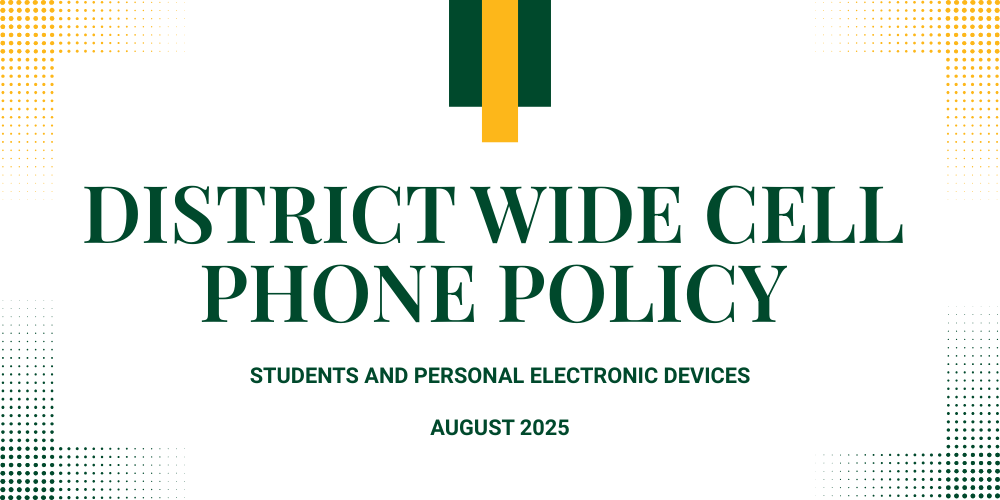Dear RCS Families,
I am writing to share important information about our school district's implementation of New York State's new requirements regarding cell phones and electronic devices during the school day. Our policy, required by New York State, represents a significant step forward in creating optimal learning environments where every student can thrive academically, socially, and emotionally. You will also be receiving building-level communications that will provide you with more specifics about this important change.
Creating Focus-Rich Learning Environments
Our new policy aligns with compelling research showing that when students are free from digital distractions, remarkable things happen in the classroom. Without the constant pull of notifications, texts, and social media, schools are observing:
Enhanced concentration and deeper learning as students engage more fully with lessons and classroom discussions
Improved academic performance through sustained attention and reduced cognitive load
Stronger peer relationships as students connect face-to-face during breaks and collaborative work
Increased participation in class activities and meaningful classroom dialogue
The Science Behind Screen-Free Learning
Research from The Anxious Generation by Jonathan Haidt provides powerful evidence supporting phone-free school environments. Dr. Haidt's extensive research demonstrates that constant phone access contributes to increased anxiety and depression among young people, while phone-free schools show significant improvements in:
Mental health outcomes with reduced anxiety and improved mood regulation
Social skill development as students practice real-world interpersonal communication
Academic achievement through the elimination of multitasking and digital distractions
Sleep quality as students develop healthier relationships with technology
The data is clear: when schools create phone-free environments, students report feeling less anxious, more connected to their peers, and more engaged in learning.
Supporting Your Child's Success
This policy change offers tremendous benefits for your child's development:
Academic Growth: Without digital interruptions, students can develop deeper focus skills that serve them throughout their educational journey and beyond.
Social Connection: Face-to-face interactions during lunch, breaks, and group work help students build essential communication skills and meaningful friendships.
Emotional Well-being: Reduced social media pressure during school hours provides a healthy respite that supports mental health and self-esteem.
Digital Balance: Learning to be present without devices helps students develop healthy technology habits for life.
How We're Implementing This Policy
Students may bring phones to school, but must store them in designated areas for the duration of the school instructional day (bell to bell)
Emergency communication between families and students will be facilitated through our main offices
Teachers and staff are prepared to support students in adjusting to this change with understanding and encouragement
Clear guidelines ensure consistent implementation across all schools in our district
Working Together
We understand this represents a significant change for many families, and we recognize that some parents may feel anxious about not having constant contact with their children during school hours. These concerns are completely natural—as parents ourselves, we understand the desire to stay connected and ensure our children's safety and well-being.
Please be assured that communication pathways remain open:
Student-to-Parent Communication: At the elementary level, students can contact you through the Main Office. At the secondary level, students can contact you through the Main Office, or through classroom phones with staff permission. Secondary-level students can also email you through their school accounts during appropriate times, such as lunch or study periods, to share important information or simply check in. Please be aware that all email communication is monitored through our districtwide cybersafety software.
Parent-to-Student Communication: At all levels, you can call the Main Office to get a message to your child. At the secondary level, you can email your child's school account, and they will be able to check messages during designated times throughout the day. Please be aware that all email communication is monitored through our districtwide cybersafety software.
Urgent Communication: For time-sensitive matters or emergencies, you can always call your school’s Main Office. Our staff will promptly deliver any important messages to your child.
Daily Connection: Remember that you'll still have full communication with your child before and after school, just as families did for generations while building strong, healthy relationships.
We're committed to supporting both students and parents through this transition. We encourage you to:
Discuss the benefits of focused learning time with your child
Establish consistent technology boundaries at home that reinforce school expectations
Trust that this policy will enhance your child's educational experience while maintaining necessary communication channels
Contact us with any questions or concerns
A Brighter Future
This policy reflects our commitment to giving students the gift of undistracted learning time—something increasingly rare in our hyperconnected world. We're creating spaces where curiosity flourishes, friendships deepen, and academic growth accelerates.
The research is overwhelmingly positive: students in phone-free schools are happier, more engaged, and more successful. We're excited to provide this supportive environment where your child can reach their full potential.
Thank you for your partnership in supporting this important initiative. Together, we're fostering an educational environment where every student can thrive.
In Service,
Craig P. Chandler
For questions about this policy or support during the transition, please contact your child’s school administrative team. We're here to help ensure every student's success.

